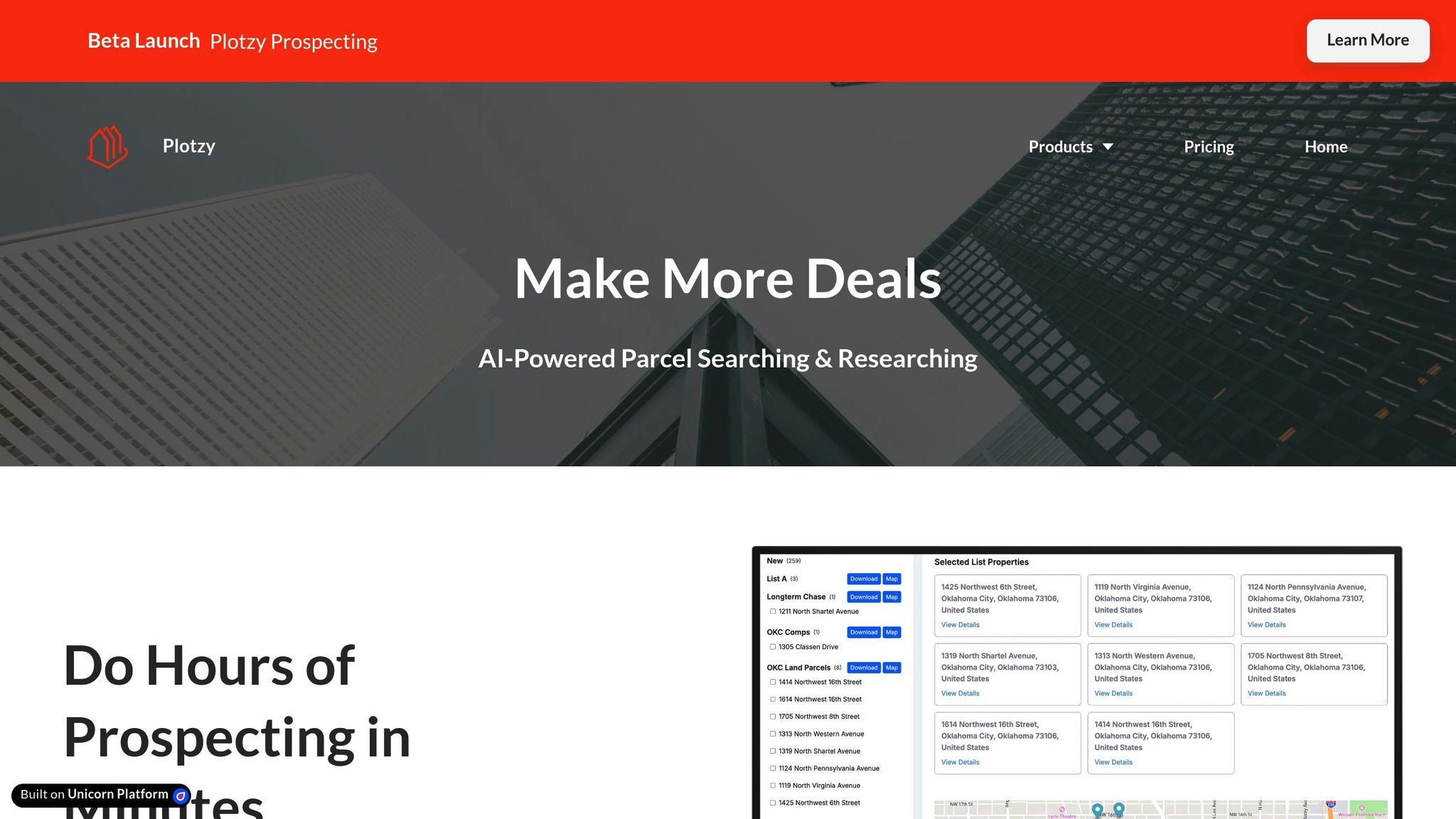Texas zoning is unique due to its localized approach, allowing cities to set their own zoning rules. Here’s a quick breakdown:
- Zoning Basics: Texas designates areas for residential, commercial, industrial, and agricultural use. Houston stands out by using land-use ordinances instead of traditional zoning.
- City Classification:
- Home Rule Cities: Flexible zoning for cities over 5,000 people.
- General Law Cities: Follow stricter state guidelines.
- Common Zoning Types:
- Residential (R): Homes, apartments.
- Commercial (C): Offices, shops.
- Industrial (I): Factories, warehouses.
- Mixed-Use (MU): Combined residential and commercial spaces.
- Planned Development (PD): Custom projects like master-planned communities.
Tools and Resources
- Finding Zoning Maps: Use city planning portals, county records, or TxDOT’s Map Grid Search.
- AI Tools: Platforms like Plotzy simplify zoning research with instant zoning checks, advanced filtering, and custom reports.
Changing Zoning
- Notify nearby property owners and publish notices before public hearings.
- Work with local zoning boards and city councils for approvals.
Zoning impacts property value, development potential, and investment opportunities. Stay updated on changes by engaging with local planning offices and using AI tools for efficient research.
Finding and Reading Texas Zoning Maps
Where to Get Zoning Maps
Many Texas municipalities offer digital zoning maps on their official websites. For a broader starting point, the Texas Department of Transportation (TxDOT) provides a Map Grid Search application, which helps locate county-specific maps. For more in-depth property research, check out local city planning portals or county records. These resources often include both current zoning designations and historical records.
| Access Method | Description | Best Use |
|---|---|---|
| City Planning Portals | Official zoning maps and GIS databases | Finding current zoning designations |
| County Records Office | Historical zoning documents and deed records | Researching property history |
| TxDOT Map Grid | County-level maps with transportation layers | Understanding regional planning context |
Once you have a map, the next step is learning how to interpret its symbols.
Reading Zoning Map Symbols
To make sense of a zoning map, you'll need to decode its symbols. On Texas zoning maps, you’ll typically find:
- Bold outlines marking district boundaries.
- Hatched patterns indicating overlay districts or special zones.
- Alphanumeric codes tied to specific zoning classifications.
Each city or county provides a legend that explains these symbols. Be sure to review the local legend to ensure you’re interpreting the map correctly.
Special Zones and Districts
Under Section 211 of Title 7 of the Texas Local Government Code, Texas cities can designate special-purpose districts. These districts often come with unique rules and opportunities:
- Transit-Oriented Development (TOD) Districts: These encourage development near transit hubs, promoting accessibility and growth.
- Historic Preservation Overlays: Regulations in these areas aim to protect historic buildings and landmarks.
- Form-Based Code Districts: These focus on building form and design, rather than traditional land use restrictions.
The National Zoning Atlas project has cataloged these special districts across Texas’s major metro areas as of 2024. When researching these zones, pay attention to details like permitted uses, design guidelines, development standards, and any potential incentives or restrictions. These factors can reveal opportunities or limitations for property development.
AI Tools for Zoning Research
Plotzy's Main Features

Plotzy uses AI to streamline zoning research, offering tools to search parcels by zoning classification and permitted uses. Here’s what you can do with it:
- Instant Zoning Verification: Check zoning designations and permitted uses in seconds.
- Advanced Parcel Search Filters: Refine searches based on property attributes and zoning categories.
- Owner Contact Database: Find property owner details for deal sourcing.
- Custom Zoning Reports: Create detailed reports on zoning status and restrictions.
The Pro plan, priced at $200 per month, includes unlimited property searches and access to extensive zoning data. This makes it a time-saving alternative to traditional research methods.
AI vs Manual Research Methods
Unlike manual research - which often involves on-site visits and juggling multiple databases - Plotzy automates zoning verification and data retrieval. This approach minimizes errors and speeds up the process, delivering accurate results without the hassle of manual cross-referencing.
Using Plotzy for Property Checks
If you're researching properties in Texas, Plotzy makes it straightforward:
- Enter the address or parcel number to retrieve basic zoning details.
- Instantly confirm the zoning designation and permitted uses.
- Generate a report covering zoning restrictions, property specifics, and ownership information.
For properties in special districts or overlay zones, Plotzy lets you layer different data points. This helps evaluate how zoning rules might influence a property's development potential.
How does Houston plan without zoning?
sbb-itb-11d231f
Working with City Zoning Offices
Using map data and AI tools is helpful, but direct interaction with local zoning offices is just as important when navigating property regulations.
Understanding Local Zoning Rules
Local zoning regulations are managed by planning and zoning departments. These departments handle zoning requests, prepare reports for the Planning & Zoning Commission, and assist the Zoning Board of Adjustments. They provide key information on property requirements, making them an essential resource. If you're looking to modify property zoning, here’s how to get started.
Changing Property Zoning
Steps for changing property zoning in Texas:
-
Public Hearing Notifications
- Notify property owners within 200 feet of the property in writing at least 10 days before the hearing.
- Publish a notice in an official newspaper at least 15 days before the city council hearing.
-
Planning & Zoning Commission Review
The Planning & Zoning Commission evaluates rezoning requests and makes recommendations to the city council. -
Zoning Board of Adjustments (ZBA)
The ZBA reviews appeals, evaluates special exception requests, and considers variance applications.
Both the zoning commission and city council must hold public hearings before approving any zoning changes, amendments, or district updates.
Identifying Off-Market Properties
Local zoning reports can be a goldmine for finding off-market opportunities. Staff reports prepared for the Planning & Zoning Commission often highlight potential development opportunities and property restrictions.
Understanding variance procedures and special exception guidelines is also crucial, as these vary by city in Texas. Regularly engaging with planning staff, attending public hearings, and reviewing staff reports can uncover promising investment opportunities. Consistent communication with local zoning offices can give you an edge in identifying these hidden gems.
Summary for Texas Investors
This section highlights key takeaways for Texas real estate investors, focusing on zoning's impact, research techniques, and staying updated on regulatory changes.
Zoning and Property Value
For Texas investors, zoning plays a critical role in shaping property values. Zoning designations determine how land can be used, directly influencing its development potential and market appeal. Properties with more flexible zoning often have higher values because they allow for varied development opportunities. For example, converting a residential property to commercial use can significantly increase its value by opening up new possibilities for development.
"Zoning laws control how land can be used and developed and determine property values." - A-List Properties
Special Purpose Districts (SPDs) are another factor to consider. These districts address specific community needs, such as flood control or historic preservation, which can also impact property value and usage.
Property Research Steps
Conducting thorough property research in Texas requires both traditional methods and modern tools. Platforms like Plotzy’s Pro features can simplify this process by offering AI-powered insights. Here’s a streamlined approach:
-
Initial Property Assessment
- Use AI tools to filter parcels based on permitted uses.
- Generate zoning reports instantly for quick insights.
-
Detailed Analysis
- Examine local regulations and identify any variances.
- Consider how surrounding properties are being used.
-
Value Evaluation
- Assess the property's development potential.
- Evaluate market demand and calculate ROI based on zoning allowances.
This approach ensures a comprehensive understanding of the property while saving time.
Tracking Zoning Updates
Keeping up with zoning changes is vital for spotting new investment opportunities. Local planning departments frequently revise zoning regulations, which can directly affect property values and development potential. To stay ahead:
- Monitor updates from local planning departments.
- Attend public hearings and planning commission meetings.
- Review staff reports for insights into potential development projects.
- Leverage tools like Plotzy’s zoning layers to track changes in property designations.
Engaging with local planning offices and staying informed about regulatory updates ensures you’re making well-informed investment decisions.
FAQs
How is zoning in Texas unique compared to other states?
Zoning in Texas stands out because there are no statewide zoning laws. Instead, zoning is managed at the local level, allowing cities and towns to create regulations tailored to their specific needs. This leads to significant differences in zoning rules from one city to another.
In Texas, cities are classified as either home rule or general law cities, which determines the extent of their zoning authority. Counties, on the other hand, typically have limited zoning power. This localized approach provides flexibility but requires careful research when navigating zoning regulations for real estate development or investment.
What are the advantages of using AI tools like Plotzy for zoning research instead of traditional methods?
Using AI tools like Plotzy for zoning research offers several key advantages over manual methods:
- Time Efficiency: AI can quickly process and analyze zoning maps, regulations, and property data, saving you hours or even days of manual research.
- Accuracy and Insights: AI-powered platforms reduce the risk of human error and provide detailed insights, helping you make more informed decisions.
- Simplified Access: With user-friendly features, AI tools make it easier to navigate complex municipal zoning information and identify opportunities for site selection or off-market deals.
By leveraging AI, you can streamline your zoning research and focus on strategic planning for your real estate investments in Texas.
How do special-purpose districts in Texas influence real estate investment decisions?
Special-purpose districts in Texas play a key role in shaping real estate investments by defining specific rules for land use, development, and compliance. These districts often regulate what types of projects are permitted, impose building design standards, and enforce environmental guidelines.
For investors, understanding these districts is crucial to identifying opportunities and avoiding potential setbacks. By knowing the unique requirements of a district, you can make informed decisions about site selection, project feasibility, and long-term investment strategies.

